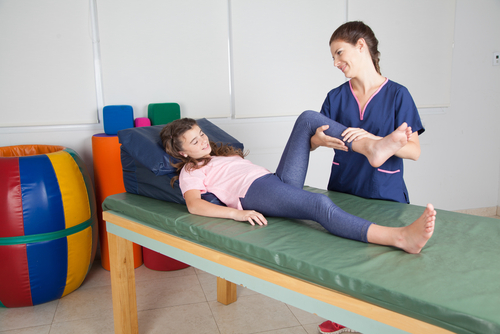
It is important to take note of how your child grows. As they get older, you may notice that they are not physically developing the way that they should. There are many common orthopedic issues present in children. Many of them will correct themselves without treatment. Sometimes, however, the conditions get more severe over time. At some point you may need to come to Central Orthopedic to get a situation corrected. Here are some common, and treatable, conditions that are common for children.
Flat Feet
Many babies are born with flat feet. Normally, they will develop arches as they grow older. Sometimes their arches may not ever fully develop, however. If this is the case, it still may not be cause for alarm. Doctors don’t often recommend treatment for flat feet unless the situation is painful for the child. Parents may worry that being flat footed will make their child clumsy, but that isn’t usually the case. If you are alarmed about flat feet or weak ankles, get your child checked out. The most a doctor will likely recommend is arch supports for your child’s shoes.
Toe Walking
When toddlers are learning to walk, it is common to see them learning on their toes. This habit usually corrects itself by age 3, but it can last longer for some children. Toe walking shouldn’t be a major cause for concern at first. However, if your toddler continues to walk this way after they turn 3, you should bring them to a doctor. Walking on both toes, or even just one, could be cause of a greater condition. These possibilities include:
- Cerebral Palsy
- Autism
- Nervous System Disorders
- Muscle Weakness
If your child is otherwise healthy but continues toe walking, your doctor may suggest they go to a physical therapist. There they will be taught stretching exercises that could correct the problem.
In-Toeing (Pigeon Toes)
It is natural for babies’ legs to turn in towards each other around 8 to 15 months, or whenever they begin standing. This could cause them to start walking in-toed, or pigeon toed. There are several causes to this. It could be a perfectly normal variation in the way your little one’s legs and feet line up. However, if your child is walking in-toed and they have a tendency to trip, they could actually have internal tibial torsion. This condition involves the lower part of the leg rotating inward. If this happens after age 3 or 4, your child might have femoral anteversion. This means that they have a greater than normal bend in the upper part of their leg. This causes their upper leg to rotate inward. Sometimes pigeon toes could also indicate cerebral palsy, but it is not very common. Treatment is not usually suggested for pigeon toes. Doctors can, however, can supply special shoes or braces for the condition. Normally, this is something that will correct itself over time.

Bowleggedness
Sometimes, orthopedic issues can be inherited. Bowleggedness is one of those conditions. Basically, bowleggedness is an exaggerated outward bending of the legs from the knees down. This is normal in infants and can correct itself as the baby gets older. If the condition continues past age 2, and only one leg, it could be an indication of a bigger problem. There are 2 common conditions that bowleggedness can lead to:
- Rickets: Rickets is a bone growth problem that is typically the result of a lack of vitamin D, or calcium. This causes severe bowing of the legs and can can lead to muscle pain and enlargement of the spleen and liver. Rickets is not very common these days, but it can happen. An increase in vitamin D and calcium is usually enough to correct the problem, but if Rickets is genetic, your child might need special treatment from an endocrinologist.
- Blount Disease: Blount disease is a condition that causes abnormal growth of the tibia bone which is at the top of the lower leg by the knee joint. It is first noticeable when the child is about 2. Blount disease can occur very suddenly and worsen quickly. If the condition does not correct itself, the child may need a brace or even surgery when they are still a toddler. The cause of Blount disease is unknown.
If your child shows signs of bowleggedness on only one side of their body, or it gets progressively worse, take them to the doctor.
It is always better to be safe than sorry. If your child shows signs of any of these conditions, feel free to make an appointment with Central Orthopedic Group for a complete examination.
